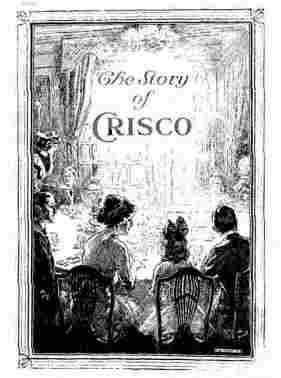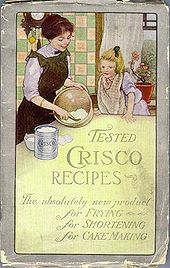Crisco – how marketing trumped nutrition!
 I recently came across the interesting story of how and why Crisco was developed and marketed. The history of Crisco is essentially the history of our modern lab-created, highly processed food. Through highly successful marketing, lab food has gradually and insidiously replaced many of our delicious and healthy traditional foods.
I recently came across the interesting story of how and why Crisco was developed and marketed. The history of Crisco is essentially the history of our modern lab-created, highly processed food. Through highly successful marketing, lab food has gradually and insidiously replaced many of our delicious and healthy traditional foods.
History of Crisco
Crisco, which is derived from crystallized cottonseed oil, was invented by Procter & Gamble in the early 1900’s. Candle maker William Procter and soap maker James Gamble launched their company in 1837. P&G’s Ivory soap, made from hydrogenated cottonseed oil, had been very successful. Ivory was the first mass-produced branded soap, replacing the bulk soap previously sold at local stores. The process of hydrogenation, initially developed by chemists to produce soap, proved to be useful to create Crisco as well. Crisco was invented by chemists, not developed by cooks in kitchens. Sound appetizing? Why would you want to eat it?
The Marketing of Crisco
Crisco was introduced in 1911 and initially marketed by paying customers (such as train lines) to use it instead of lard. Testimonials from doctors and rabbis (as a kosher substitute for lard and butter) were solicited and society teas were held in many U.S. cities at which all the baked foods were made with Crisco.
P&G published a cookbook, The Story of Crisco, where all of the 615 recipes used Crisco and which praised its benefits and versatility. The cookbook became very popular, partly because it was often given away free, prompting many home cooks to begin using Crisco for their baking.
The introduct ion to the Crisco cookbook gives a highly favorable view of the newly invented fat, calling it an “altogether new and better fat.” The book emphasizes the digestibility of Crisco calling it a healthier alternative to lard and butter. Even more concerning is that Crisco is specifically promoted for children. [source]
ion to the Crisco cookbook gives a highly favorable view of the newly invented fat, calling it an “altogether new and better fat.” The book emphasizes the digestibility of Crisco calling it a healthier alternative to lard and butter. Even more concerning is that Crisco is specifically promoted for children. [source]
Health Problems with Crisco
The hydrogenation process used to make Crisco creates a plastic-like fat with a much higher melting temperature than the oils it is made from. This “plastic” fat contains trans fatty acids which are dangerous because they “are sufficiently similar to natural fats that the body readily incorporates them into the cell membrane; once there their altered chemical structure creates havoc with thousands of necessary chemical reactions—everything from energy provision to prostaglandin production.” [source]
P&G did not know at first about the dangers of trans fatty acids, but here’s what happened when evidence began to appear about problems of heart disease, cancer, learning disorders, and infertility:
“P&G worked behind the scenes to cover them up. One scientist who worked for P&G, Dr. Fred Mattson, can be credited with presenting the US government’s inconclusive Lipid Research Clinics Trials to the public as proof that animal fats caused heart disease. He was also one of the baleful influences that persuaded the American Heart Association to preach the phony gospel of the Lipid Hypothesis.” [source]
The New Crisco
Maybe as a result of these increasing problems from trans fats, P&G divested itself in 2002 of the Crisco brand, which is now produced by J. M. Smucker Co. The current formula for Crisco is not made with cottonseed oil but is a “blend of soybean oil, fully hydrogenated palm oil, and partially hydrogenated palm and soybean oils.” [source] Even though it’s claimed that “a serving” of the new Crisco is trans fat-free, legally defined as containing less than 0.5 g of trans fat, notice that Crisco still includes hydrogenated oils and is still a highly processed, lab-created food. It probably contains as much trans fat as allowed without having to admit it. It is not really trans fat-free, nor is any product that includes hydrogenated oils. [source]
The Success of Crisco
P&G’s cottonseed oil Crisco was such a huge marketing success that my mother, grandmother, aunts, and almost every other cook I knew growing up used Crisco to cook just about everything–fried foods like chicken, cakes, pies, biscuits, and on and on. They believed, just like the advertising said, that everything cooked better in Crisco. They believed it was healthy and safe–never questioned it. We didn’t even have any butter or lard in the house. Were people more gullible to marketing then? No, I don’t think so. We all need to find out about the foods we eat, know the sources, how they were grown and prepared, and avoid boxes and packages of processed foods. Never just believe advertising without research!
Although now I try to eat traditional, nutritious foods and cook with healthy fats, I may never know the extent of the damage to my health caused by the Crisco and the other lab-created “foods” I ate for so many years.
Note on Cottonseed Oil:
This is not directly related to the history of Crisco, but I’ve always found it strange that we eat cottonseed oil. Cotton itself is not and, as far as I know, has never been used as a food, other than for animals. So why is the oil of the cotton seed called a “vegetable” oil and used in so many foods? To meet regulations, cottonseed oil must be refined, bleached, and deodorized to remove a toxic compound called gossypol. Cottonseed oil is used primarily because it is a cheap by-product of the cotton industry. [source]
An additional problem with cottonseed oil today is that, as of 2012, 80% of U.S. cotton is genetically engineered. [source] More research is needed to understand the effect of genetic engineering on the oil of a plant.
Sources
Crisco: Product-Driven Marketing Evolution by Seth Goding
The Story of Crisco by Marion Harris Neil
Crisco, Wikipedia
The Rise and Fall of Crisco by Linda Joyce Forristal
Man’s Most Important Food is Fat: The Use of Persuasive Techniques in Proctor & Gamble’s Public Relations Campaign to Introduce Crisco, 1911-1913 by Susan C. Pendleton
The Oiling of America by Mary G. Enig, PhD, and Sally Fallon
Cottonseed oil, Wikipedia
Healthy Crisco? by Heather Gehlert
Related Real Food Houston posts
10 Reasons Cholesterol is Necessary for Health
Why eating fat doesn’t make you fat!
Update July 3, 2013: There is a good review of the marketing history of Crisco at The Weston A. Price Foundation website. Marketing Crisco
Update January 23, 2015: More information about the origin of Crisco–Who Killed Lard?
Update May 26, 2019: “Oddly enough, the company to thank for the fact that America now eats so much vegetable oil has never produced much in the way of food. Thanks to Procter & Gamble the United States boosted the production of a waste product of cotton farming, cottonseed oil.” For more information about this related subject: How Vegetable Oils Replaced Animal Fats in the American Diet.
Update July 14, 2019: The brand name Crisco is an acronym of Crystallized Cottonseed Oil. (Source)
Update December 13, 2021: “For decades, Crisco had only one ingredient, cottonseed oil. But most consumers never knew that. That ignorance was no accident.” How Crisco toppled lard – and made Americans believers in industrial food

Yuck! Crisco is so nasty! Yes, it does make good pie crusts, but at what cost? *sigh* It’s sad, my mom grew up on lard for the most part, because she lived in the country and on a farm for part of her life, but by the time she had us children, she had switched to shortening, because she thought it was healthier for us. It’s frustrating how these lies get so stuck in your head, that even when you know the right answer, you feel like second guessing yourself because it has just been pumped at you so much. It has been hard for me to get past all of these lies (from the “experts”) I grew up with. I am hoping that all the blogging we are doing will help lessen the impact of those lies over time for others. It was a very well done blog post! Thank you for sharing it.
Yes, it does make good pie crusts, but at what cost? *sigh* It’s sad, my mom grew up on lard for the most part, because she lived in the country and on a farm for part of her life, but by the time she had us children, she had switched to shortening, because she thought it was healthier for us. It’s frustrating how these lies get so stuck in your head, that even when you know the right answer, you feel like second guessing yourself because it has just been pumped at you so much. It has been hard for me to get past all of these lies (from the “experts”) I grew up with. I am hoping that all the blogging we are doing will help lessen the impact of those lies over time for others. It was a very well done blog post! Thank you for sharing it.
Lynn
Hi Lynn,
Yes Crisco is nasty, and I’ve discovered that lard makes better piecrusts and biscuits. They taste better made with lard, and they’re easier to work with. My family loves lard biscuits and piecrusts. What a shame that we believed the advertising and didn’t use lard for so many years. Lard from pastured pigs is both healthier and tastier than Crisco. It’s also too bad that today most grocery store lard is hydrogenized to increase shelf life. I’m glad you’re with us helping to reverse some of the damage from those lies.
Pingback:Sunday Snippets
The marketing language in that booklet is priceless! “Today you buy this rich, wholesome cream of nutritious food oils in sanitary tins.”
I am a huge fan of vintage advertising and it was because of my study of old food brands that I became interested in, and concerned about, the industrialization of the food supply. This article reminds me of James Lileks’ pages devoted to Spry shortening. Though this brand isn’t around anymore, it was a competitor of Crisco and it gives you an idea of how Big Food used folksy characters like “Aunt Jenny” to promote their product. The writer’s commentary about the subject is hilarious (if not a bit PG-13 in places so you’ve been warned) such as calling it “proletarian cooking glop”! So true!
Worth a look:
http://lileks.com/institute/gallery/spry/index.html
Thanks for the link about Spry. It’s hilarious! It’s hard to believe, now that I know better, that we were (are?) so gullible about our food.
Pingback:These 11 Charts Show Everything That's Wrong With The Modern Diet R - Page 2 | Mark's Daily Apple Health and Fitness Forum page 2
Pingback:High Fat vs Low Fat - Sandi K Keto Coach